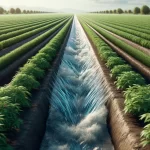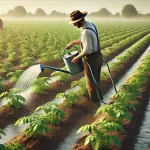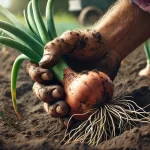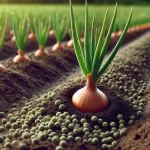Importance of Irrigation in Onion Cultivation
Proper irrigation management is essential for onion cultivation, as the water supply directly influences growth, bulb development, and the quality of the final product. Well-managed irrigation not only ensures high yields but also minimizes the risk of diseases associated with excess moisture or water deficiency.
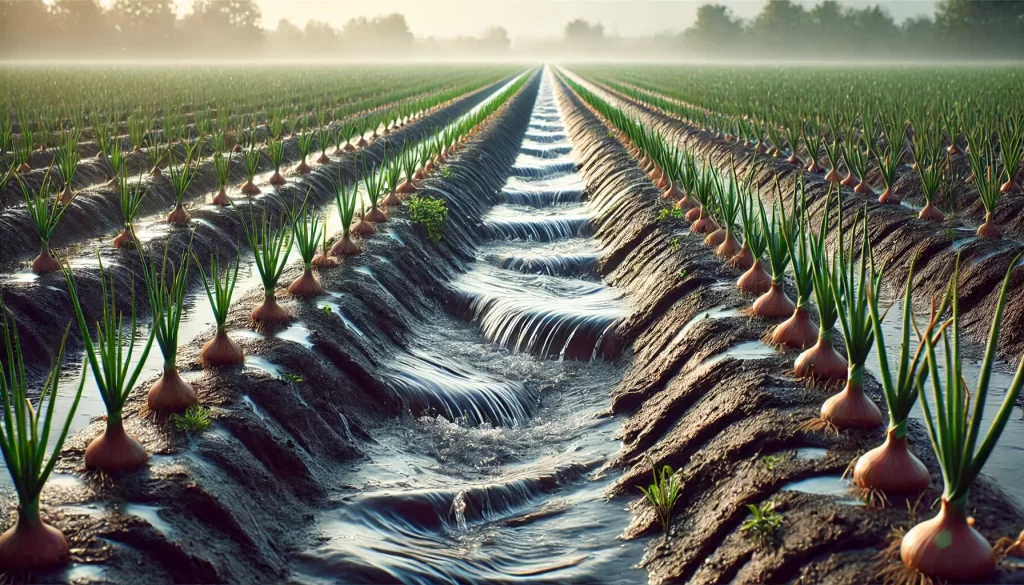
Water Requirements of Onion
Factors Affecting Water Requirements
The water requirements of onion cultivation vary according to several factors:
- Growth Stage: Different stages of onion development require varying amounts of water.
- Soil Type: Sandy soils retain less water and require more frequent irrigation, while clay soils retain more moisture, allowing for less frequent irrigation.
- Climate: High temperatures and wind can increase soil water evaporation, increasing the crop’s water demand.
- Root Depth: Onions have a shallow root system, making them more susceptible to water stress.
Water Requirements by Growth Stage
- Germination and Establishment (0-30 days):
- Water Requirement: Moderate.
- Goal: Keep the soil moist to ensure uniform germination and seedling establishment.
- Vegetative Growth (30-60 days):
- Water Requirement: High.
- Goal: Promote leaf growth and a strong root system.
- Bulb Formation (60-90 days):
- Water Requirement: High.
- Goal: Provide enough water to maximize bulb size and quality.
- Maturation (90 days onward):
- Water Requirement: Low.
- Goal: Reduce irrigation to prevent bulb rot and facilitate the maturation process.
Irrigation Systems for Onion Cultivation
Drip Irrigation
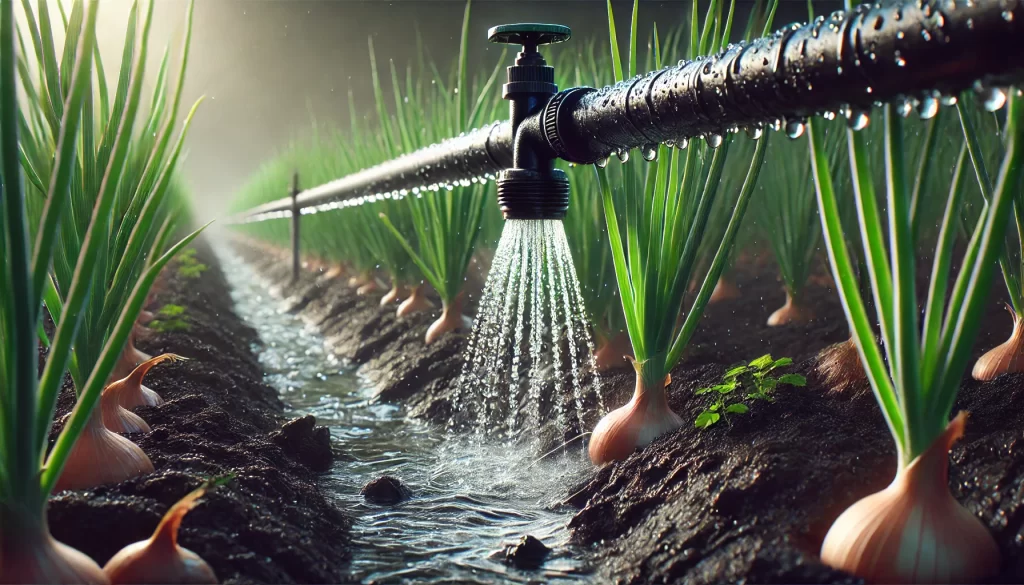
Advantages
- Water Use Efficiency: Delivers water directly to the root zone, minimizing losses due to evaporation.
- Reduced Disease: By avoiding water contact with foliage, the risk of fungal diseases is reduced.
- Compatibility with Fertigation: Facilitates the application of fertilizers through the irrigation system, improving nutrient use efficiency.
Disadvantages
- Initial Cost: Requires a significant investment in infrastructure.
- Maintenance: May require regular maintenance to prevent emitter clogging.
Sprinkler Irrigation
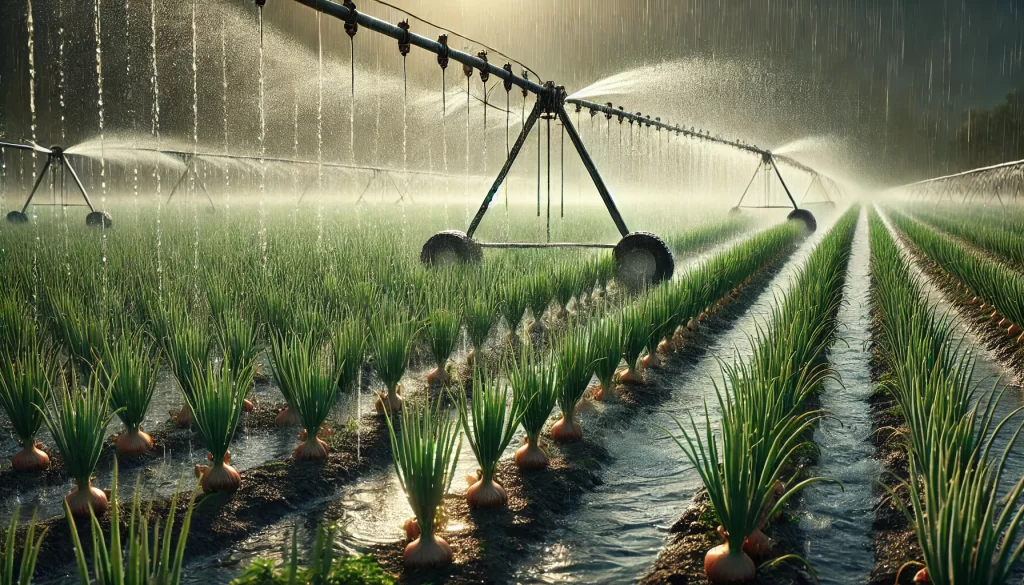
Advantages
- Wide Coverage: Suitable for large and irregularly shaped areas.
- Ease of Implementation: Relatively easy to install and operate compared to other irrigation systems.
Disadvantages
- Evaporation Losses: Higher evaporation, especially in windy conditions.
- Risk of Fungal Diseases: Can increase foliage humidity, promoting diseases like downy mildew.
Gravity Irrigation

Advantages
- Low Cost: Does not require a large initial investment.
- Simplicity: Easy to implement on fields with adequate slope.
Disadvantages
- Water Inefficiency: High water loss due to runoff and evaporation.
- Risk of Waterlogging: Can cause drainage problems and waterlogging, especially in heavy soils.
Irrigation Management in Onion Cultivation
Irrigation Scheduling
Criteria for Irrigation Scheduling
Irrigation scheduling should be based on:
- Growth Stage: Adjust irrigation according to the specific water needs of each crop stage.
- Soil Moisture Monitoring: Use tensiometers, moisture probes, or other tools to measure soil moisture and adjust irrigation accordingly.
- Climatic Conditions: Adapt irrigation to weather forecasts, increasing it during dry periods and reducing it during rain.
Irrigation Frequency and Duration
- Frequency: Will depend on soil type and climatic conditions. Sandy soils may require more frequent but smaller water applications.
- Duration: Sufficient to moisten the root zone without causing waterlogging. The goal is to maintain consistent soil moisture without saturating it.
Efficient Irrigation Techniques
Controlled Deficit Irrigation
Controlled deficit irrigation is a technique that involves reducing the amount of water applied during certain growth stages, such as maturation, to improve water use efficiency without significantly compromising yield.
Mulching
Mulching with organic or plastic materials helps conserve soil moisture, reduce evaporation, and control weeds. This is especially useful in arid climates.

Fertigation
Fertigation, or the application of fertilizers through the irrigation system, is a technique that allows for the uniform distribution of nutrients along with water, improving the efficiency of both resource uses.
Water Management in Onion Cultivation
Water Quality Considerations
Salinity
Irrigation water with high salinity can negatively affect onion cultivation, causing water stress and reducing bulb growth. It is essential to monitor the electrical conductivity (EC) of the water and take corrective measures if necessary, such as mixing with lower salinity water or improving soil drainage.
Contamination
The use of water contaminated with pathogens, heavy metals, or chemicals can be harmful to the crop. It is important to ensure that the water used comes from clean and safe sources.
Drainage Management
A good drainage system is essential to avoid waterlogging, which can lead to bulb rot and disease proliferation. This includes:
- Field Design: Implement a design that allows for efficient natural drainage.
- Subsurface Drains: In soils with drainage problems, consider installing subsurface drains.
- Drainage System Maintenance: Ensure that drainage channels are clean and functioning properly, especially during rainy seasons.
Water Conservation Strategies
Night Irrigation
Nighttime or early morning irrigation can reduce evaporation, improving water use efficiency.

Runoff Reduction
Implement practices such as land leveling and the use of vegetative barriers to reduce surface runoff and maximize water infiltration into the soil.
Technological Innovations in Onion Irrigation
Soil Moisture Sensors
The use of moisture sensors allows real-time monitoring of soil moisture, enabling more precise decision-making on when and how much to irrigate.
Automated Irrigation Systems
Automated irrigation systems that use computer-controlled technology and meteorological data can optimize water use, automatically adjusting irrigation rates based on crop needs and weather conditions.
Subsurface Drip Irrigation
Subsurface drip irrigation is an innovation that places water emitters below the soil surface, delivering water directly to the root zone. This reduces evaporation and improves irrigation efficiency, although it requires a higher initial investment.
Impact of Water Management on Onion Crop Quality and Yield
Effects on Bulb Quality
Proper irrigation management has a direct impact on bulb quality. Excessive irrigation can lead to problems such as rot or the formation of soft bulbs, while water deficiency can result in small, misshapen bulbs. Maintaining optimal water balance is key to producing high-quality bulbs.

Crop Yield
Onion crop yield is highly correlated with water management. Efficient irrigation and drainage management can maximize the crop’s yield potential, ensuring that plants have enough water during critical development stages without experiencing water stress.
 AgronoBlog – Agriculture Blog
AgronoBlog – Agriculture Blog 